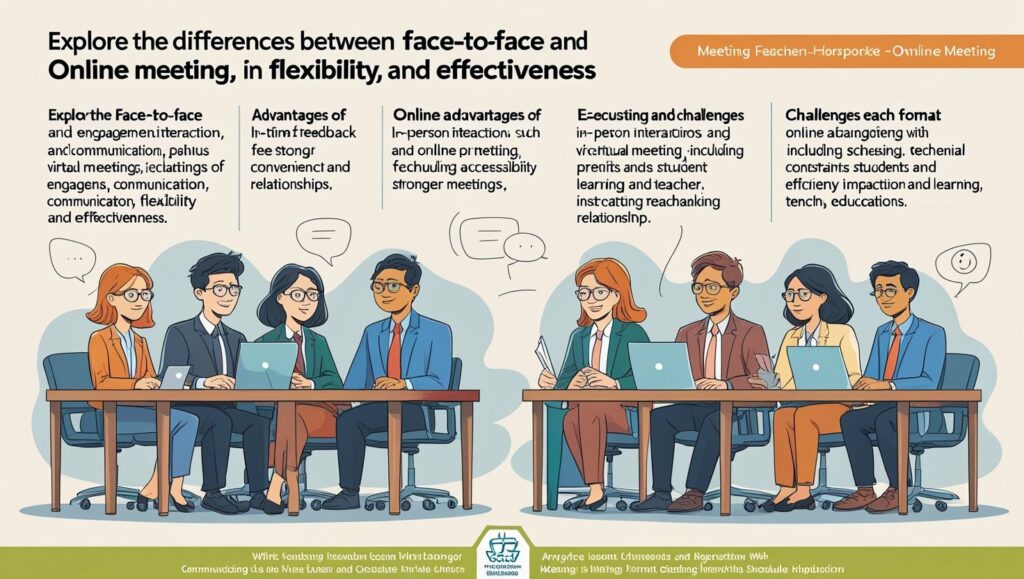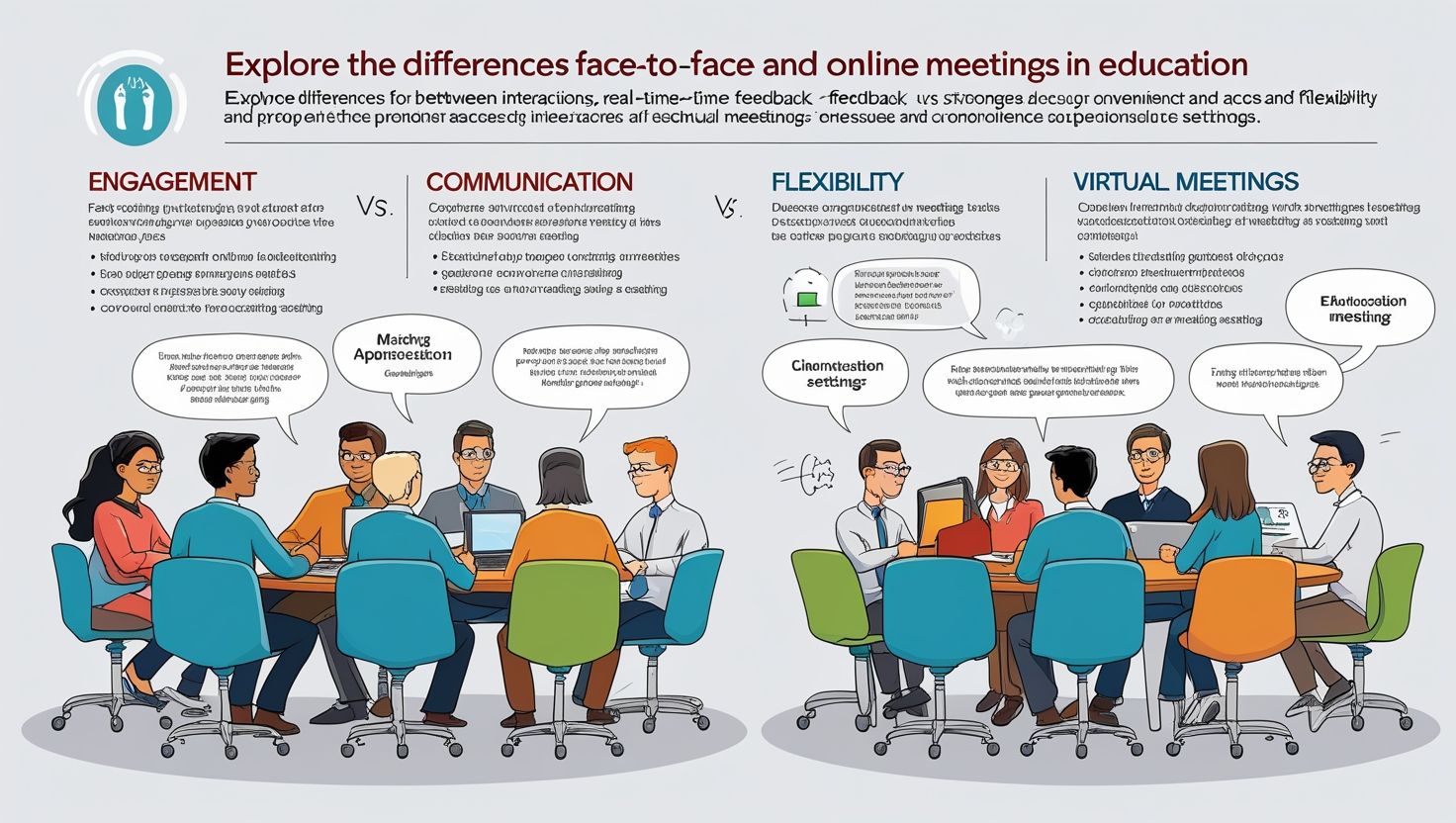Face-to-Face vs. Online Meetings in Education, Face-to-Face vs. Online Meetings in Education, Face-to-face meetings have long been the cornerstone of traditional education. In a physical classroom, students and teachers interact directly, fostering a sense of community and engagement. One of the most significant advantages of face-to-face meetings is the immediacy of communication. Teachers can observe students’ body language, facial expressions, and tone of voice, allowing them to gauge understanding and adjust their teaching methods accordingly. This real-time feedback is invaluable in addressing students’ needs and ensuring that learning objectives are met.
Another benefit of face-to-face meetings is the opportunity for spontaneous interaction. In a classroom setting, students can ask questions, participate in discussions, and collaborate with their peers. This interactive environment encourages active learning and critical thinking, which are essential for academic success. Additionally, face-to-face meetings provide a structured routine, which can help students develop time management and organizational skills. The physical presence of a teacher also serves as a motivator, as students are more likely to stay focused and engaged when they are accountable to someone in person.
However, face-to-face meetings in education also have their drawbacks. They require a fixed schedule and location, which can be inconvenient for students with other commitments, such as work or family responsibilities. Additionally, traditional classrooms may not accommodate diverse learning styles, as they often follow a one-size-fits-all approach. This can be particularly challenging for students with needs or those require personalized attention. Furthermore, face-to-face meetings can be resource-intensive, requiring physical infrastructure, transportation, and other logistical considerations.
The Rise of Online Meetings in Education
The advent of technology has revolutionized the way education is delivered, with online meetings becoming increasingly popular. Online meetings, also known as virtual classrooms, allow students and teachers to connect from anywhere in the world, breaking down geographical barriers. One of the most significant advantages of online meetings is their flexibility. Students can access lectures, participate in discussions, and complete assignments at their own pace, making it easier to balance education with other responsibilities. This is particularly beneficial for non-traditional students, such as working professionals or parents, who may not have the time to attend physical classes.
Another advantage of online meetings is the ability to leverage digital tools and resources. Virtual classrooms often come equipped with features such as screen sharing, recording, and interactive whiteboards, which can enhance the learning experience. For example, recorded lectures allow students to revisit material as needed, while interactive tools facilitate collaboration and engagement. Additionally, online meetings can accommodate a larger number of students, making education more accessible to a wider audience. This is particularly important in regions where access to quality education is limited.
However, online meetings also have their challenges. One of the most common issues is the lack of face-to-face interaction, which can lead to feelings of isolation and disconnection. Students may miss the social aspect of traditional classrooms, such as group discussions and peer support, which can impact their motivation and engagement. Additionally, online meetings require a reliable internet connection and access to technology, which may not be available to all students. This digital divide can exacerbate existing inequalities in education. Furthermore, online meetings can be prone to technical issues, such as connectivity problems or software glitches, which can disrupt the learning process.

The Complementary Nature of Face-to-Face and Online Meetings in Education
While face-to-face and online meetings each have their own set of advantages and disadvantages, they are not mutually exclusive. In fact, they can complement each other in various ways, depending on the context and objectives of the educational program. For example, face-to-face meetings may be more suitable for hands-on learning, such as laboratory experiments or practical training, where physical presence and direct supervision are essential. On the other hand, online meetings may be more appropriate for theoretical subjects, where flexibility and accessibility are prioritized.
In some cases, a blended learning approach may be the most effective solution. This involves combining face-to-face and online meetings to create a hybrid learning environment. For instance, a course may include in-person lectures for interactive discussions and group activities, while online components are used for self-paced learning and assessment. This approach allows educators to leverage the strengths of both modes of communication, providing students with a more comprehensive and flexible learning experience. Blended learning also encourages the development of digital literacy skills, which are increasingly important in today’s technology-driven world.
The Impact of Face-to-Face and Online Meetings on Student Outcomes
The effectiveness of face-to-face and online meetings in education can be measured by their impact on student outcomes, such as academic performance, engagement, and satisfaction. Research has shown that face-to-face meetings tend to result in higher levels of student engagement and participation. A study by Chen, Lambert, and Guidry (2010) found that students in traditional classrooms were more likely to interact with their peers and instructors, leading to better academic performance. This is attributed to the immediacy of communication and the social dynamics of a physical classroom.
On the other hand, online meetings have been found to improve accessibility and flexibility, which can lead to higher levels of student satisfaction. A study by Means, Toyama, Murphy, Bakia, and Jones (2010) found that online learning can be just as effective as face-to-face learning, particularly when it incorporates interactive elements and personalized feedback. However, the success of online meetings largely depends on the quality of the technology and the level of support provided to students. For example, students who have access to reliable internet and technical assistance are more likely to succeed in online learning environments.
Conclusion
In conclusion, both face-to-face and online meetings play a crucial role in education, each offering unique benefits and challenges. Face-to-face meetings provide immediacy, interaction, and a sense of community, while online meetings offer flexibility, accessibility, and a range of digital tools. The choice between the two depends on the specific needs and context of the educational program, and in many cases, a combination of both may be the most effective approach. As technology continues to evolve, it is likely that the lines between face-to-face and online meetings will continue to blur, offering new opportunities for innovation and collaboration in education.
References
- Chen, P.-S. D., Lambert, A. D., & Guidry, K. R. (2010). Engaging Online Learners: The Impact of Web-Based Learning Technology on College Student Engagement. Computers & Education, 54(4), 1222-1232.
- Means, B., Toyama, Y., Murphy, R., Bakia, M., & Jones, K. (2010). Evaluation of Evidence-Based Practices in Online Learning: A Meta-Analysis and Review of Online Learning Studies. U.S. Department of Education.
- Garrison, D. R., & Vaughan, N. D. (2008). Blended Learning in Higher Education: Framework, Principles, and Guidelines. Jossey-Bass.
- Allen, I. E., & Seaman, J. (2010). Learning on Demand: Online Education in the United States, 2009. Sloan Consortium.
- Bernard, R. M., Abrami, P. C., Borokhovski, E., Wade, C. A., Tamim, R. M., Surkes, M. A., & Bethel, E. C. (2009). A Meta-Analysis of Three Types of Interaction Treatments in Distance Education. Review of Educational Research, 79(3), 1243-1289.

